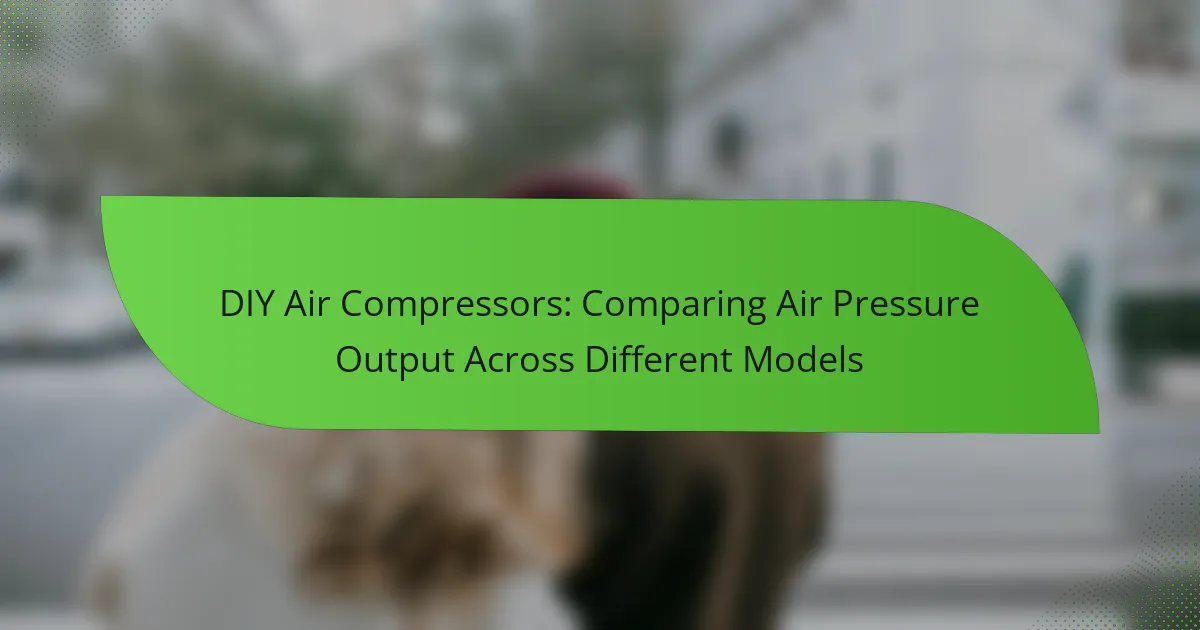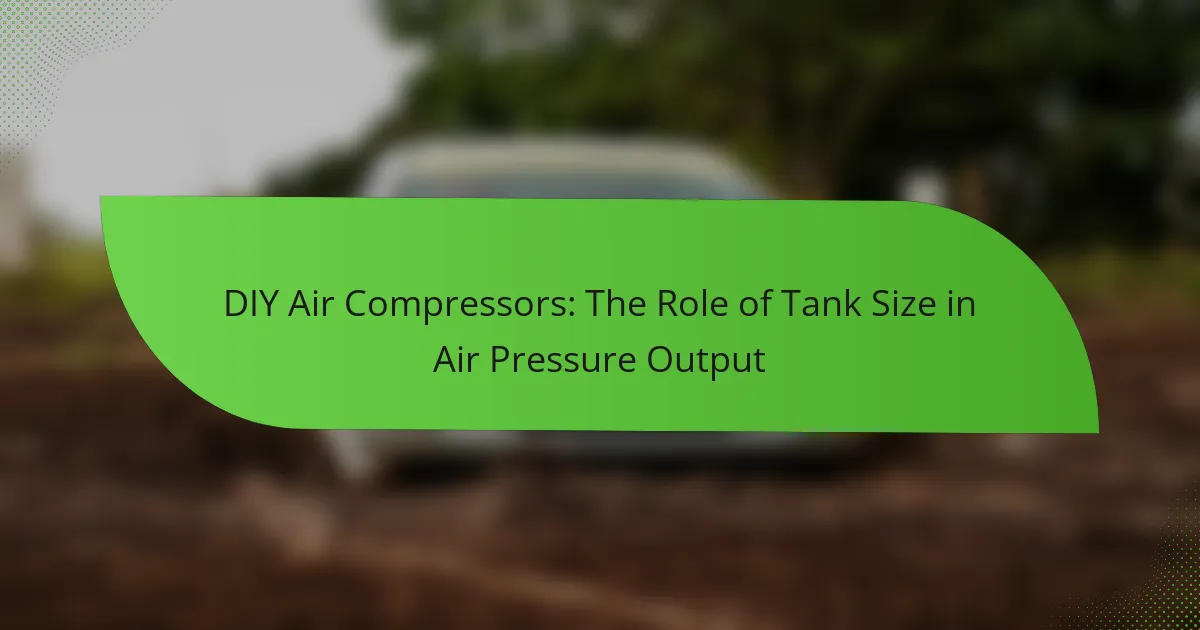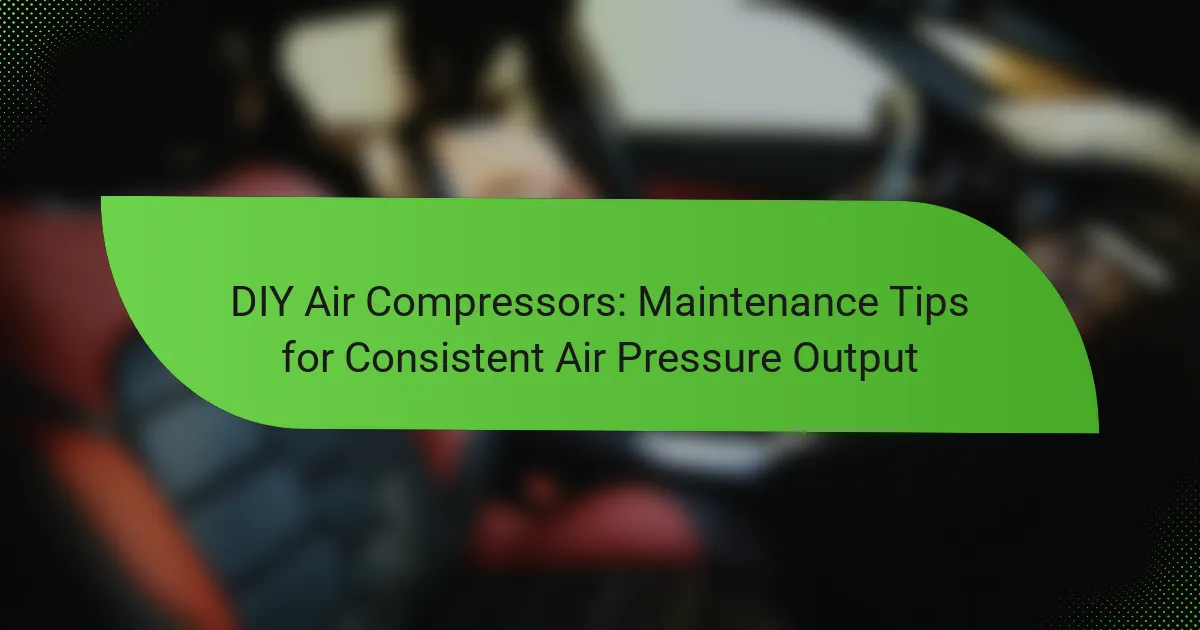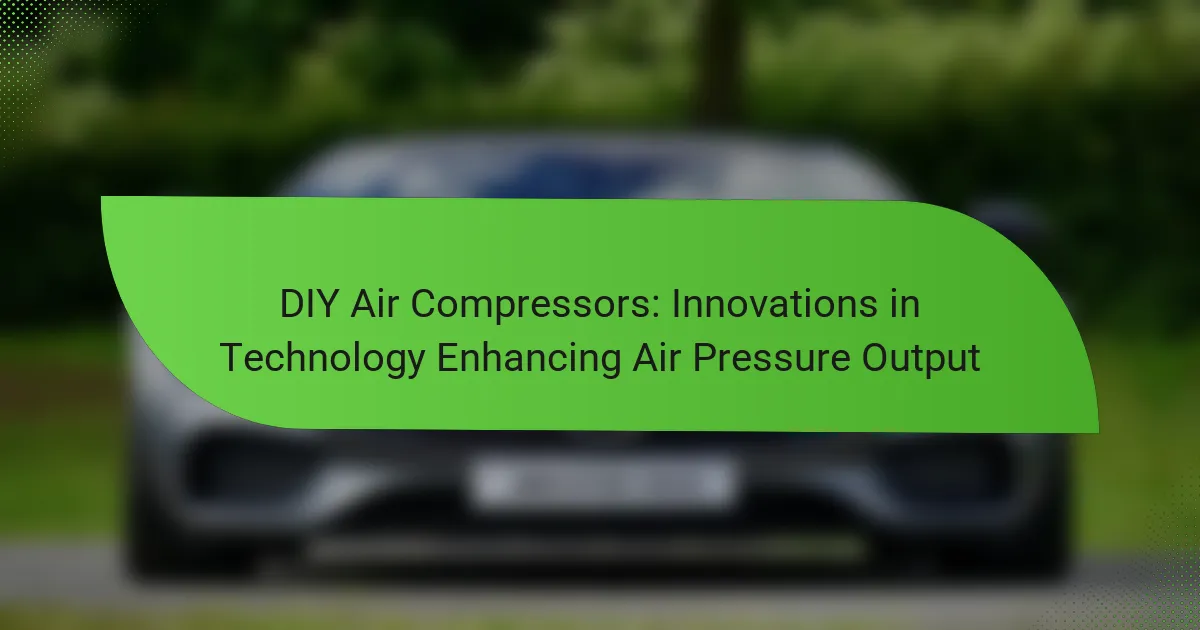DIY air compressors are devices designed to compress air for various applications, including powering pneumatic tools, inflating tires, and spraying paint. Constructed from readily available materials, these compressors can differ in design and size based on their intended use. The article emphasizes the importance of safety measures during the construction and operation of DIY air compressors, detailing essential practices such as wearing personal protective equipment, ensuring stability, and using pressure relief valves. Additionally, it covers maintenance tips to optimize air pressure output, including regular filter checks, cleaning, and monitoring pressure settings to prevent over-pressurization and enhance performance. Overall, the article provides a comprehensive overview of best practices for safely building and maintaining DIY air compressors.
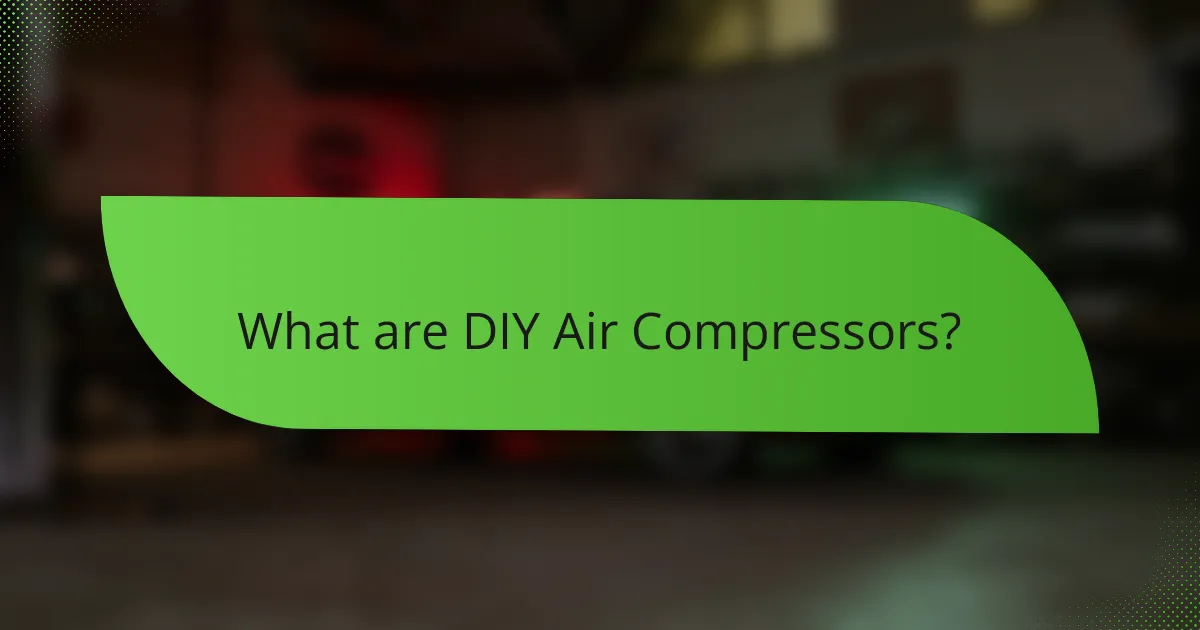
What are DIY Air Compressors?
DIY air compressors are devices that compress air for various applications. They are typically built using readily available materials and components. Common applications include powering pneumatic tools, inflating tires, and spraying paint. DIY air compressors can vary in design and size, depending on the intended use. They often utilize a motor, a pump, and a storage tank. The efficiency and output pressure can depend on the quality of the components used. Safety measures are crucial when constructing and using DIY air compressors to prevent accidents. Proper maintenance and adherence to guidelines enhance their performance and longevity.
How do DIY Air Compressors function?
DIY air compressors function by converting power into potential energy stored in pressurized air. They typically use an electric motor or a gasoline engine to drive a piston or a rotary screw. The motor compresses air in a chamber, reducing its volume and increasing its pressure. This pressurized air is then stored in a tank for later use. When needed, the compressed air is released through a valve, providing a powerful stream of air for various applications. The efficiency of a DIY air compressor can depend on factors like tank size and motor power. Proper assembly and maintenance are crucial for optimal performance and safety.
What are the essential components of a DIY Air Compressor?
The essential components of a DIY air compressor include a motor, a pump, a tank, and pressure regulation components. The motor powers the pump, which compresses air. The tank stores compressed air for later use. Pressure regulation components ensure safe and efficient operation. Each component plays a critical role in the overall functionality of the air compressor. For instance, the tank size affects the amount of air stored, impacting the compressor’s efficiency. Proper selection and assembly of these components are vital for optimal performance and safety.
How does each component contribute to air pressure output?
The components of an air compressor each play a vital role in air pressure output. The motor powers the compressor, converting electrical energy into mechanical energy. The pump compresses air, increasing its pressure as it moves through the system. The pressure switch regulates the output pressure by turning the motor on and off at preset levels. The tank stores compressed air, providing a reserve that maintains consistent pressure during use. The pressure gauge displays the current air pressure, allowing users to monitor output levels. The filter cleans the air entering the system, preventing contaminants from affecting performance. Each component’s efficiency directly impacts the overall air pressure output. For instance, a well-maintained pump can achieve higher pressure levels compared to a worn one.
Why are safety measures important for DIY Air Compressors?
Safety measures are important for DIY air compressors to prevent accidents and injuries. Air compressors operate under high pressure, which can lead to explosive failures if not handled properly. Proper safety protocols reduce the risk of equipment malfunction and ensure user protection. For instance, using safety valves can prevent excessive pressure buildup. Additionally, wearing protective gear can shield users from potential hazards. According to the Occupational Safety and Health Administration (OSHA), improper use of air compressors accounts for numerous workplace injuries each year. Implementing safety measures is crucial for maintaining a safe working environment.
What are the common risks associated with DIY Air Compressors?
Common risks associated with DIY air compressors include explosion hazards, improper pressure regulation, and electrical hazards. Explosion hazards arise from over-pressurization of the tank. This can occur if safety valves are not installed or malfunctioning. Improper pressure regulation can lead to equipment damage or personal injury. Electrical hazards may result from using inadequate wiring or faulty components. Additionally, there are risks of noise-induced hearing loss due to high decibel levels. Inadequate ventilation during operation can also lead to carbon monoxide buildup. Lastly, lack of personal protective equipment increases the risk of injury while using air compressors.
How can safety measures prevent accidents and injuries?
Safety measures can prevent accidents and injuries by minimizing risks associated with using DIY air compressors. Proper safety protocols include wearing personal protective equipment such as goggles and gloves. Regular maintenance checks can identify potential hazards before they lead to accidents. Ensuring the compressor is used in a well-ventilated area reduces the risk of inhaling harmful fumes. Following manufacturer guidelines for pressure limits prevents equipment failure. Training users on safe operation techniques significantly lowers the chance of mishandling. Statistics indicate that workplaces with safety measures in place see a 40% reduction in accidents. Implementing these measures creates a safer environment for all users.
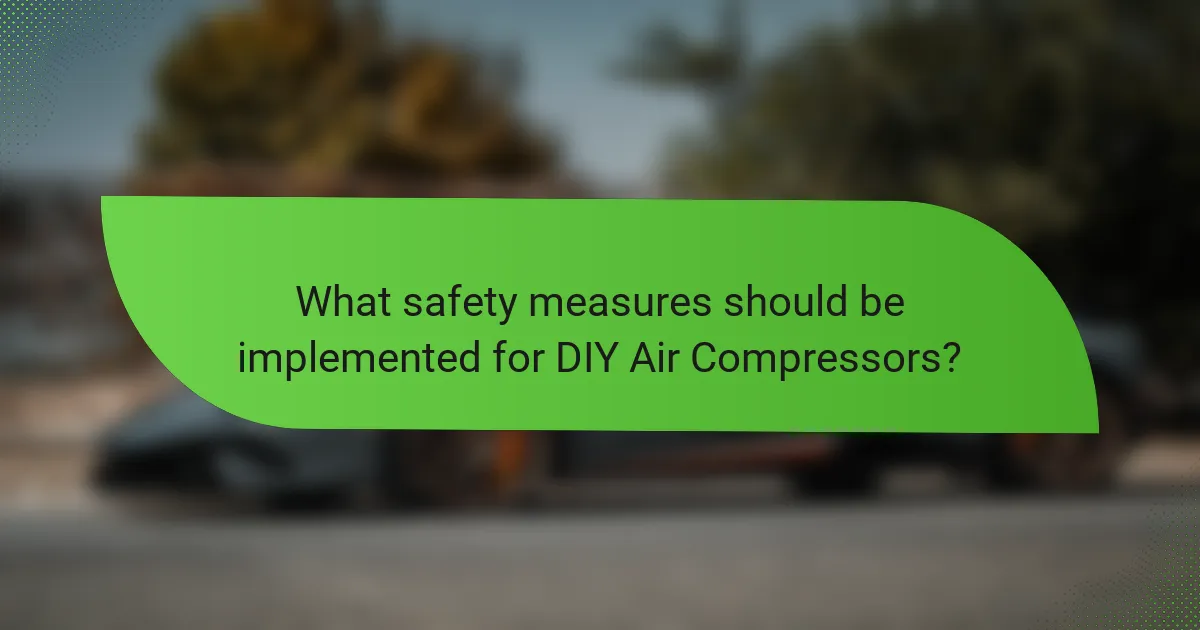
What safety measures should be implemented for DIY Air Compressors?
Implementing safety measures for DIY air compressors is crucial to prevent accidents. First, always wear appropriate personal protective equipment, such as safety goggles and gloves. Ensure the compressor is placed on a stable surface to avoid tipping. Use a pressure relief valve to prevent over-pressurization. Regularly inspect hoses and connections for leaks or wear. Maintain proper ventilation to avoid inhaling harmful fumes. Follow the manufacturer’s guidelines for pressure settings and usage. Finally, keep the compressor away from flammable materials to reduce fire risk. These measures significantly enhance safety during operation.
How can proper maintenance enhance safety in DIY Air Compressors?
Proper maintenance enhances safety in DIY air compressors by preventing malfunctions and accidents. Regularly checking for leaks reduces the risk of explosions. Inspecting hoses and fittings ensures they are secure and free from wear. Cleaning air filters improves airflow and prevents overheating. Draining moisture from the tank prevents rust and corrosion, which can compromise structural integrity. Monitoring pressure levels ensures the compressor operates within safe limits. Following manufacturer guidelines for maintenance schedules is crucial for optimal performance. Regular maintenance can reduce the likelihood of injuries related to equipment failure.
What routine checks should be performed on a DIY Air Compressor?
Routine checks for a DIY air compressor include inspecting the air filter, checking the oil level, and ensuring the safety valve operates correctly. The air filter should be clean to maintain airflow efficiency. Inspecting the oil level is crucial for proper lubrication and to prevent overheating. The safety valve must function to release excess pressure, preventing potential hazards. Additionally, checking for leaks in hoses and fittings is essential for maintaining pressure. Regularly tightening connections helps ensure safety during operation. Cleaning the compressor’s exterior prevents dust accumulation, which can affect performance. Finally, testing the pressure gauge verifies accurate readings for optimal air pressure output.
How does maintaining air pressure levels contribute to safety?
Maintaining air pressure levels contributes to safety by preventing equipment failure and accidents. Proper air pressure ensures that tools operate within their designed specifications. When air pressure is too high, it can lead to equipment rupture or explosion. Conversely, low air pressure can cause tools to malfunction or perform inadequately. According to the Occupational Safety and Health Administration (OSHA), maintaining appropriate pressure levels is crucial for reducing the risk of workplace injuries. Regular monitoring of air pressure helps identify potential hazards before they escalate. Adhering to manufacturer guidelines for pressure settings enhances overall operational safety.
What personal protective equipment (PPE) is recommended when using DIY Air Compressors?
The recommended personal protective equipment (PPE) when using DIY air compressors includes safety goggles, ear protection, and gloves. Safety goggles protect the eyes from debris and particles that may be expelled during operation. Ear protection is essential to mitigate the risk of hearing damage from high noise levels typically associated with air compressors. Gloves provide hand protection from sharp objects and potential chemical exposure. Additionally, a dust mask may be advisable to prevent inhalation of harmful dust or fumes. These protective measures align with safety guidelines to minimize risks while operating air compressors.
What types of PPE should be worn during operation?
During operation, the types of personal protective equipment (PPE) that should be worn include safety goggles, gloves, and hearing protection. Safety goggles protect the eyes from flying debris and potential chemical splashes. Gloves provide hand protection from sharp objects and hazardous materials. Hearing protection is essential to prevent hearing damage from loud noise generated by air compressors. According to the Occupational Safety and Health Administration (OSHA), using appropriate PPE significantly reduces the risk of injury in hazardous work environments.
How does PPE mitigate risks when using DIY Air Compressors?
PPE mitigates risks when using DIY air compressors by providing essential protection to the user. Personal protective equipment, such as safety goggles, protects the eyes from debris and flying particles. Hearing protection, like earplugs or earmuffs, reduces the risk of hearing damage from loud compressor noise. Respirators filter harmful airborne particles and fumes, ensuring clean air intake during operation. Gloves protect hands from cuts, abrasions, and potential chemical exposure. Steel-toed boots provide foot protection from heavy equipment and accidental drops. Each type of PPE addresses specific hazards associated with air compressor use, significantly reducing the likelihood of injuries. Proper use of PPE is crucial for maintaining safety and health while operating DIY air compressors.

What are the optimal practices for achieving the best air pressure output?
To achieve the best air pressure output, regular maintenance of the air compressor is essential. This includes checking and replacing filters to ensure optimal airflow. Keeping the compressor clean prevents dust and debris from affecting performance. Additionally, using the correct size and type of hose minimizes pressure loss during operation.
Setting the compressor to the appropriate pressure level for the task is crucial. Over-pressurizing can lead to equipment damage. Monitoring the pressure gauge helps maintain the desired output.
Lastly, ensuring all connections are tight and leak-free maximizes efficiency. Regularly inspecting for leaks can prevent air loss, ensuring consistent performance. These practices collectively enhance air pressure output and extend the compressor’s lifespan.
How can users ensure they are achieving optimal air pressure?
Users can ensure they are achieving optimal air pressure by regularly checking and adjusting their air compressor settings. First, users should refer to the manufacturer’s specifications for the recommended pressure levels. Next, they can use a reliable pressure gauge to monitor the current air pressure. Regularly inspecting hoses and fittings for leaks is crucial, as leaks can lead to pressure loss. Additionally, users should maintain their compressors by cleaning filters and checking oil levels if applicable. Keeping the compressor in a well-ventilated area can also help maintain optimal performance. Following these steps can significantly enhance the efficiency and safety of air pressure output.
What techniques can improve air pressure efficiency?
Techniques to improve air pressure efficiency include regular maintenance, proper sizing of components, and optimizing airflow. Regular maintenance involves checking for leaks and ensuring all parts are functioning correctly. Proper sizing of air compressors and pipes minimizes pressure drops. Optimizing airflow can be achieved by using high-quality filters and ensuring unobstructed paths. These techniques enhance overall efficiency and reduce energy consumption. Research shows that a well-maintained system can save up to 30% in energy costs.
How does the environment affect air pressure output in DIY Air Compressors?
Environmental factors significantly influence air pressure output in DIY air compressors. Temperature variations can lead to changes in air density. Higher temperatures decrease air density, resulting in lower air pressure output. Conversely, lower temperatures increase air density, which can enhance pressure output. Humidity also plays a role; moist air is less dense than dry air. This means that in humid conditions, air compressors may produce lower pressure. Altitude affects air pressure as well; higher altitudes have thinner air, which can reduce the efficiency and output of compressors. These environmental factors are crucial in ensuring optimal performance and safety in DIY air compressor operations.
What troubleshooting tips can help maintain optimal air pressure output?
Regularly check and adjust the pressure settings on the air compressor. This ensures the output matches the required specifications. Inspect hoses and fittings for leaks, as they can reduce pressure efficiency. Tighten any loose connections to prevent air loss. Clean or replace air filters to maintain airflow and prevent blockages. Monitor the compressor’s duty cycle to avoid overheating, which can affect performance. Ensure the intake area is free from obstructions to allow proper air intake. Lastly, schedule routine maintenance checks to identify potential issues before they affect pressure output.
What are common issues that affect air pressure in DIY Air Compressors?
Common issues that affect air pressure in DIY air compressors include leaks in the system, improper maintenance, and inadequate power supply. Leaks can occur in hoses, fittings, or the tank itself. They can significantly reduce the air pressure output. Improper maintenance, such as neglecting to change filters or oil, can lead to decreased efficiency. An inadequate power supply may prevent the compressor from reaching optimal pressure levels. Additionally, using the wrong size or type of compressor for a specific task can also affect air pressure. Regular inspection and maintenance can help mitigate these issues.
How can users diagnose and fix air pressure problems effectively?
Users can diagnose and fix air pressure problems effectively by following a systematic approach. First, check the air compressor’s pressure gauge to determine if the pressure is within the recommended range. If the pressure is too low, inspect for leaks in hoses and connections. Tighten any loose fittings to prevent air loss. Next, examine the air filter for blockages. A clogged filter can restrict airflow and lower pressure. Replace or clean the filter as needed. Additionally, ensure that the compressor’s tank drain valve is closed properly to maintain pressure. If the problem persists, test the pressure switch for functionality. A malfunctioning switch may fail to regulate pressure correctly. Lastly, consult the user manual for specific troubleshooting steps related to your compressor model. Regular maintenance can prevent future issues, ensuring optimal air pressure output.
DIY air compressors are devices that compress air for various applications, including powering tools and inflating tires. This article provides a comprehensive overview of the essential components, functionality, and safety measures associated with DIY air compressors, emphasizing the importance of proper maintenance and adherence to safety protocols. Key topics include the roles of individual components in air pressure output, common risks, recommended personal protective equipment (PPE), and optimal practices for achieving efficient performance. By understanding these aspects, users can enhance both safety and effectiveness when operating DIY air compressors.
